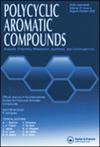基于度数的卡戈米石墨烯、碳卡戈米纳米管和纳米钛拓扑指数研究
IF 2.4
3区 化学
Q2 CHEMISTRY, ORGANIC
引用次数: 0
摘要
基于图描述符的方法已被用于化学信息学和生物信息学的分子特性预测。在本文中,我们应用分割技术和简单的计数方案来描述二维(2D)卡戈梅石墨烯的结构,然后推导出二维卡戈梅石墨烯及其管状和环状的各种基于度的拓扑指数(图描述符)的封闭形式。本文章由计算机程序翻译,如有差异,请以英文原文为准。
On Degree-Based Topological Indices of Kagome Graphene, and Carbon Kagome Nanotubes and Nanotori
Approaches based on graph descriptors have been used in cheminformatics and bioinformatics for molecular property prediction. In this article, we apply partition technique and simple counting schemes to describe the structure of a two-dimensional (2D) kagome graphene and then derive the closed form of various degree-based topological indices (graph descriptor) of 2D kagome graphene, and its tubular and toroidal forms.
求助全文
通过发布文献求助,成功后即可免费获取论文全文。
去求助
来源期刊

Polycyclic Aromatic Compounds
化学-有机化学
CiteScore
3.70
自引率
20.80%
发文量
412
审稿时长
3 months
期刊介绍:
The purpose of Polycyclic Aromatic Compounds is to provide an international and interdisciplinary forum for all aspects of research related to polycyclic aromatic compounds (PAC). Topics range from fundamental research in chemistry (including synthetic and theoretical chemistry) and physics (including astrophysics), as well as thermodynamics, spectroscopy, analytical methods, and biology to applied studies in environmental science, biochemistry, toxicology, and industry. Polycyclic Aromatic Compounds has an outstanding Editorial Board and offers a rapid and efficient peer review process, as well as a flexible open access policy.
 求助内容:
求助内容: 应助结果提醒方式:
应助结果提醒方式:


